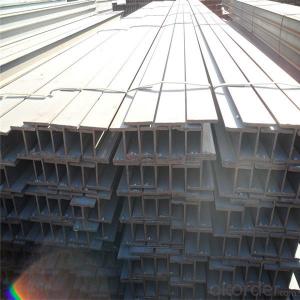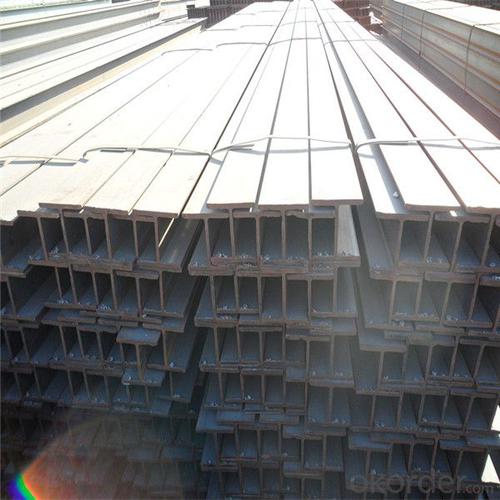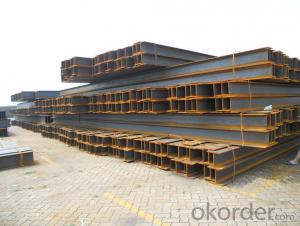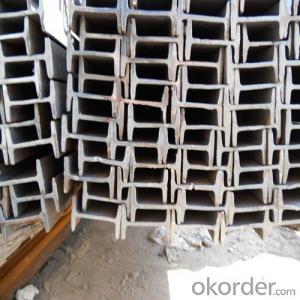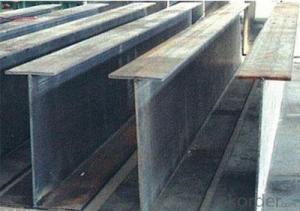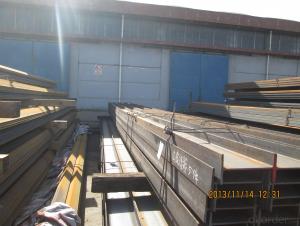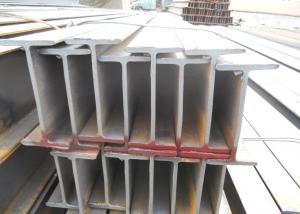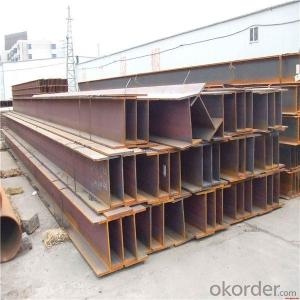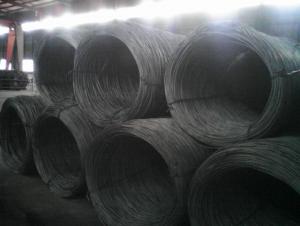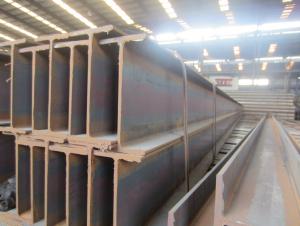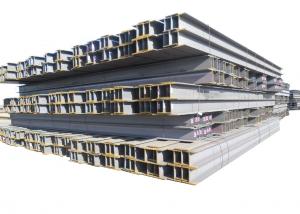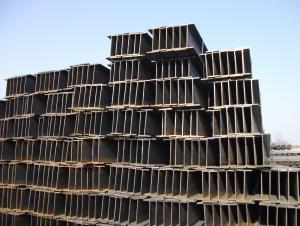Wide Flange H-Steel Beams Steel with Full Size
- Loading Port:
- Dalian
- Payment Terms:
- TT OR LC
- Min Order Qty:
- 120 m.t
- Supply Capability:
- 150000 m.t/month
OKorder Service Pledge
OKorder Financial Service
You Might Also Like
Specification
Quick Detail
Place of Origin: | Tianjin, China (Mainland) | Grade: | Q235B | Technique: | High Frequency |
Application: | Building construction,Bridge construction etc. | Length: | 6.0meters,9meters,12meters | Standard: | ASTM |
Flange Width: | 100-750mm | Flange Thickness: | 3.0-10.0mm | Web Width: | 50-250mm |
Web Thickness: | 2.3-8.0mm | Brand Name: | Liye |
We can provide qualify goods,competitive price and speedy delivery.
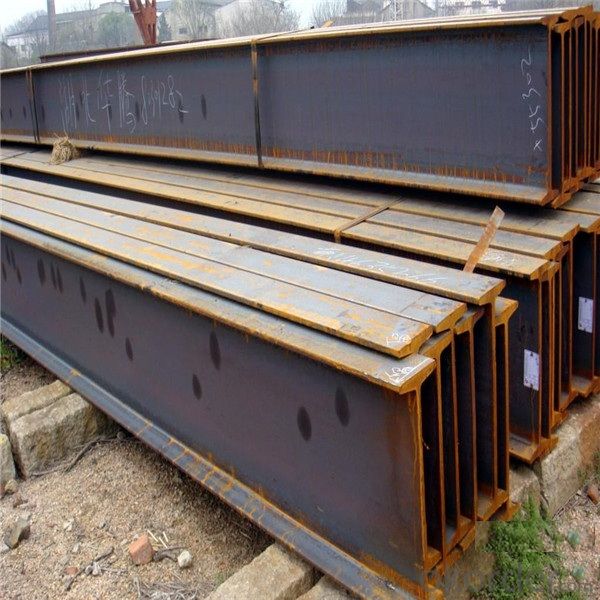
Products Description
H Type Steel Size and Theoretical Weight | |||||
Size | Theoretical Weight | Size | Theoretical Weight | Size | Theoretical Weight |
|
|
|
|
|
|
(mm) | (kg/m) | (mm) | (kg/m) | (mm) | (kg/m) |
100*50*5*7 | 9.3 | 250*125*6*9 | 29 | 446*199*8*12 | 65.1 |
100*100*6*8 | 16.9 | 250*250*9*14 | 71.8 | 450*200*9*14 | 74.9 |
125*60*6*8 | 13.1 | 294*200*8*12 | 55.8 | 482*300*11*15 | 110.8 |
125*125*6.5*9 | 23.6 | 298*149*5.5*8 | 32 | 488*300*11*18 | 124.9 |
148*100*6*9 | 31.1 | 340*250*9*14 | 36.7 | 496*199*9*14 | 77.9 |
150*75*5*7 | 14 | 300*150*6.5*9 | 93 | 500*200*10*16 | 88.1 |
150*150*7*10 | 20.7 | 300*300*10*15 | 78.1 | 582*300*12*17 | 132.8 |
175*90*5*8 | 18 | 346*174*6*9 | 41.2 | 588*300*12*20 | 147 |
175*175*7.5*11 | 40.4 | 350*175*7*11 | 49.4 | 596*199*10*15 | 92.4 |
194*150*6*9 | 29.9 | 350*350*12*19 | 134.9 | 600*200*11*17 | 103.4 |
198*99*4.5*7 | 17.8 | 390*300*10*16 | 104.6 | 700*300*13*24 | 181.8 |
200*100*5.5*8 | 20.9 | 396*199*7*11 | 56.1 | 800*300*14*26 | 206.8 |
200*200*8*12 | 49.9 | 400*200*8*13 | 65.4 | 900*300*16*28 | 240.1 |
244*175*7*11 | 43.6 | 400*400*13*21 | 171.7 |
|
|
248*124*5*8 | 25.1 | 440*300*11*18 | 120.8 |
|
|
Length=6------12meters | |||||
Packaging & Delivery
Packaging Details: | Packed with waterproof paper and steel banding. |
Delivery Detail: | 15-25 |
FAQ
1. How can I get some samples?
We are honored to offer you samples. New clients are expected to pay for the courier cost. The samples are free for you.
2 Do you have any certificates?
Our products passed inspection of SGS, FDA, and CE Quality is priority! Every worker keeps the QC from the very beginning to the very end, Quality control department especially responsible for quality checking in each process.
3 Can your factory print or emboss my logo on the goods?
Yes, we can print or emboss the logo on the goods or their packing box.
4 What information should I let you know if I want to get a quotation?
1) The specification of products (length x width x thickness);
2) The temper and alloy.
3) The final product you will use to be made
4 It will be better if you can show us the pictures or design sketch. Samples will be best for clarifying. If not, we will recommend relevant products with details for reference.We usually produce goods based on customers
Samples or based on customers’ picture, logo, sizes etc.
- Q: What are the cost implications of using steel H-beams?
- The cost implications of using steel H-beams can vary depending on various factors. Firstly, the cost of steel H-beams themselves can significantly impact the overall project budget. Steel is a widely used construction material due to its strength and durability, but it can be more expensive compared to other materials like wood or concrete. The price of steel H-beams is influenced by factors such as market demand, supply chain dynamics, and global economic conditions. Additionally, the size and dimensions of the H-beams can affect their cost. Larger and heavier H-beams will generally be more expensive as they require more steel material and may require specialized handling and transportation. Furthermore, the cost implications of using steel H-beams extend beyond the material itself. Considerations such as fabrication, installation, and maintenance expenses should also be taken into account. Fabrication costs usually include cutting, welding, and shaping the steel beams according to the project's specifications. Installation costs involve labor, equipment, and any necessary support structures. Finally, ongoing maintenance costs should be factored in, as steel requires periodic inspections, painting, and potential repairs to ensure its longevity. However, it's essential to consider the long-term benefits of using steel H-beams. Their high strength-to-weight ratio and durability make them a reliable choice for structural applications. Steel H-beams have a longer lifespan compared to other materials, reducing the need for frequent replacements or repairs. This can result in cost savings over time, as the initial investment in steel H-beams can offset the expenses associated with maintenance and replacement in the future. Ultimately, the cost implications of using steel H-beams should be evaluated in the context of the specific project requirements, budget constraints, and long-term considerations. Consulting with professionals in the construction industry, such as engineers or contractors, can provide a more accurate assessment of the cost implications and help make informed decisions.
- Q: How do you calculate the maximum bending stress in steel H-beams?
- To calculate the maximum bending stress in steel H-beams, you need to determine the moment of inertia of the cross-section and the applied bending moment. The bending stress can then be calculated using the formula: stress = (bending moment * distance from neutral axis) / (moment of inertia * section modulus).
- Q: What are the typical applications of steel H-beams?
- Steel H-beams, known as I-beams, have a unique shape and versatile properties that make them widely used in construction and structural applications. They are utilized in a variety of ways, including: 1. Construction: H-beams are commonly employed in the construction of buildings, bridges, warehouses, and industrial facilities. Their structural support and stability make them ideal for load-bearing applications. 2. Infrastructure: H-beams are extensively used in infrastructure projects such as highways, railways, and airports. They are used in the construction of supports for elevated roadways and rail tracks, as well as in the fabrication of large-scale structures like overhead gantries and pedestrian bridges. 3. Mezzanine Floors: Steel H-beams are often used to construct mezzanine floors, which are intermediate floors between main floors. H-beams provide strong support without excessive columns or support structures, allowing for efficient space utilization. 4. Industrial Machinery: H-beams find applications in the manufacturing and industrial sectors. They are used in the construction of heavy machinery, equipment frames, and supports for conveyor systems. The high strength and load-bearing capacity of H-beams make them suitable for handling heavy loads in industrial settings. 5. Shipbuilding: H-beams are commonly used in the shipbuilding industry for constructing ship hulls, decks, and bulkheads. The robust nature of steel H-beams ensures structural integrity and stability, making them suitable for withstanding the harsh marine environment and heavy loads encountered by ships. 6. Automotive Industry: Steel H-beams also find applications in the automotive industry. They are used in the fabrication of vehicle frames, chassis, and suspension systems, providing strength and rigidity for safety and performance. 7. Material Handling Equipment: H-beams are employed in the construction of material handling equipment such as cranes, forklifts, and hoists. Their structural strength enables them to handle and transport heavy loads efficiently and securely. In conclusion, the versatility, strength, and durability of steel H-beams make them suitable for a wide range of applications in various industries. They are preferred in construction and structural projects where load-bearing capacity, stability, and reliability are crucial factors.
- Q: Are steel H-beams suitable for use in earthquake-prone areas?
- The strength and durability of steel H-beams make them a common choice for construction. However, their suitability in earthquake-prone areas depends on several factors. To begin with, steel H-beams exhibit excellent resistance to tension and compression forces, making them generally suitable for seismic conditions. They are designed to evenly distribute the load, which helps mitigate the impact of earthquakes. Moreover, steel is a flexible material that can absorb and dissipate energy during seismic events. Nevertheless, the appropriateness of steel H-beams in earthquake-prone areas also relies on specific design and construction techniques. Incorporating seismic design principles and ensuring adequate connections are essential engineering practices that enhance their performance during earthquakes. In earthquake-prone regions, adherence to seismic design criteria is often required by building codes and regulations. These codes ensure that structures can withstand anticipated ground motions and minimize the risk of structural failure during seismic events. Consulting experienced structural engineers knowledgeable in designing for seismic forces is crucial for the proper utilization of steel H-beams. Additionally, consideration must be given to local geological conditions and the intensity of potential earthquakes. Designers should take into account the characteristics of ground motion, including frequency content, amplitude, and duration. This information helps engineers determine the appropriate size, shape, and spacing of steel H-beams to withstand expected seismic forces. In conclusion, steel H-beams can be suitable for use in earthquake-prone areas if they are designed and constructed following proper engineering practices and local building codes. Consulting experienced professionals and considering local geological conditions and seismic design criteria are crucial steps to ensure the safe and effective use of steel H-beams in such areas.
- Q: What is the maximum length of a steel H-beam that can be manufactured?
- The maximum length of a steel H-beam that can be manufactured depends on several factors including the manufacturing process, transportation restrictions, and practical limitations. In terms of the manufacturing process, steel H-beams are typically produced in standard lengths that can vary depending on the specific steel mill or manufacturer. These standard lengths often range from 20 to 60 feet (6 to 18 meters). However, it is important to note that longer lengths can often be custom ordered or fabricated based on specific project requirements. Transportation restrictions also play a significant role in determining the maximum length of a steel H-beam. The length of the beam must be able to fit within the constraints of transportation methods such as trucks, trains, or ships. These transportation methods have their own size limitations, and exceeding these limits may require special arrangements, permits, or even partial disassembly of the beam. Lastly, practical limitations must be considered when determining the maximum length of a steel H-beam. Longer beams can become more challenging to handle, maneuver, and install on construction sites. The weight and size of the beam can make it more difficult to transport and lift into place, potentially requiring specialized equipment or additional manpower. In conclusion, while there are standard lengths for steel H-beams, the maximum length that can be manufactured is influenced by the manufacturing process, transportation restrictions, and practical considerations. Custom orders, transportation logistics, and practical limitations all play a role in determining the maximum length of a steel H-beam.
- Q: What are the considerations for selecting the appropriate size of steel H-beams?
- When selecting the appropriate size of steel H-beams, there are several considerations to take into account. 1. Load Capacity: The primary consideration is the load capacity or weight that the H-beam will need to support. This includes the dead load (the weight of the structure itself) as well as any live loads (such as people, equipment, or snow loads) that may be applied. It is important to accurately calculate the total load to ensure that the chosen H-beam can handle the weight without being overloaded. 2. Span Length: The span length, or the distance between support points, is also an important factor in determining the appropriate size of the H-beam. Longer spans will require larger and stronger H-beams to provide the necessary support. It is important to consult structural engineering guidelines to determine the maximum allowable span length for a specific H-beam size. 3. Deflection: Deflection refers to the bending or flexing of a beam under load. Excessive deflection can cause structural issues and compromise the integrity of the building or structure. By considering the load and span length, deflection calculations can be made to ensure that the selected H-beam size will provide sufficient stiffness to limit deflection to an acceptable level. 4. Cost: The cost of the H-beam is also an important consideration. Larger and stronger H-beams tend to be more expensive. It is important to balance the load requirements with the available budget to select the most cost-effective option that still meets the structural needs. 5. Availability and Fabrication: Finally, the availability of the desired H-beam size and the ease of fabrication should also be considered. It is important to check with suppliers to ensure that the chosen size is readily available and can be easily obtained. Additionally, if the H-beams need to be customized or fabricated in a specific way, it is important to consider the ease and cost of such fabrication processes. In summary, when selecting the appropriate size of steel H-beams, considerations such as load capacity, span length, deflection, cost, availability, and fabrication must all be taken into account to ensure the structural integrity and efficiency of the project.
- Q: Light thin-walled H steel, in addition to welding, is there any hot rolling?
- Yes, the 2 largest domestic hot-rolled H steel producers are Laiwu Steel and Maanshan Iron and steel
- Q: Can steel H-beams be used in railway platforms?
- Certainly, railway platforms can utilize steel H-beams. Steel H-beams find widespread application in construction endeavours owing to their remarkable endurance, robustness, and adaptability. They offer outstanding structural reinforcement and possess the ability to bear substantial burdens, thereby making them fitting for railway platforms. Additionally, steel H-beams can be effortlessly crafted and set up, enabling expedient and economical construction. All in all, steel H-beams prove to be a trustworthy option for railway platforms, ensuring steadfastness and security for both passengers and trains.
- Q: Can steel H-beams be used for data centers?
- Indeed, data centers can utilize steel H-beams. These beams are frequently employed in construction endeavors as they possess impressive strength, endurance, and load-bearing capacities. In order to sustain the weight of equipment and infrastructure, data centers necessitate robust and steadfast structures, making steel H-beams an ideal choice. Moreover, H-beams can be effortlessly assembled and tailored to fit the precise layout and needs of a data center. By employing steel H-beams, data centers guarantee the stability and structural soundness vital for supporting the crucial operations and equipment housed within these establishments.
- Q: Can steel H-beams be used in retail store construction?
- Yes, steel H-beams can be used in retail store construction. They are commonly used as structural elements for their strength, durability, and ability to support heavy loads. Steel H-beams provide a cost-effective solution for creating open spaces, supporting mezzanines, and constructing large-scale structures in retail stores.
Send your message to us
Wide Flange H-Steel Beams Steel with Full Size
- Loading Port:
- Dalian
- Payment Terms:
- TT OR LC
- Min Order Qty:
- 120 m.t
- Supply Capability:
- 150000 m.t/month
OKorder Service Pledge
OKorder Financial Service
Similar products
Hot products
Hot Searches
Related keywords
